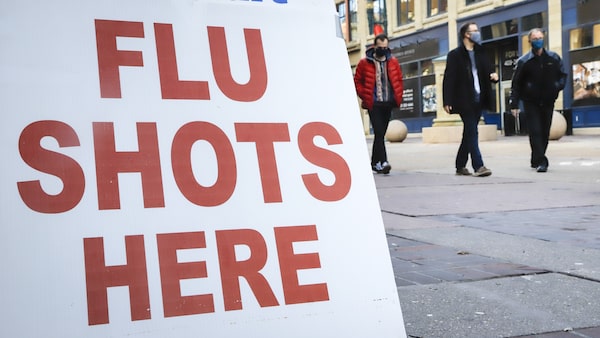
People wear masks as they pass a pharmacy offering flu shots in downtown Calgary on Oct. 30, 2020.Jeff McIntosh/The Canadian Press
John Paget was stunned.
For years, the infectious disease scientist had been studying influenza B/Yamagata, one of two main lineages of influenza B virus that sickens people around the world and dominates the annual flu season roughly every seven years. But in the spring of 2020 at the start of the COVID-19 pandemic, B/Yamagata infections plummeted. By last month, even though other flu viruses had re-emerged, B/Yamagata still had not, prompting Dr. Paget and his colleagues to wonder whether it has become extinct.
“That was just mind-boggling in the flu world, that that would happen,” said Dr. Paget, a senior researcher at the Netherlands Institute for Health Services Research, noting he and other experts aren’t yet sure what to make of its absence. “Has it really disappeared? Is it dormant? Is it waiting? Will it return?”
The apparent disappearance of B/Yamagata is just one of many unexpected effects the COVID-19 pandemic has had on the flu. And even though life for many has now returned to a pre-pandemic normal, COVID-19 continues to upend experts’ expectations of what was previously a relatively predictable seasonal virus.
For starters, the fact that influenza could be heavily suppressed through nonpharmaceutical means, like travel bans, restrictions on gatherings and school closures that were widely introduced to curb the spread of COVID-19, was something Dr. Paget said he and his colleagues had not seen evidence of. With the exception of frequent and thorough hand washing, there was very little data before the pandemic that showed these measures could affect the flu, he said, noting even the use of face masks against the flu was considered questionable.
Yet these measures brought the flu to a standstill. According to Canada’s FluWatch national surveillance system, there were sporadic positive flu tests reported, but no widespread community circulation of influenza occurred during the 2020 to 2021 flu season, mirroring the situation globally.
When provinces and territories began lifting public-health measures early this year, influenza returned as well with an unusually late start to the flu season in Canada, which typically runs from around October to March. The number of lab-confirmed flu detections began rising steeply in April, at a time when, normally, they would be declining.
Fewer than one in five Canadians have received a COVID-19 booster shot
Elsewhere, the flu’s return has not followed its usual, pre-pandemic patterns either. In Australia, where the flu season is typically from June to September, the number of reported lab-confirmed cases of influenza had surpassed the country’s five-year average by mid-April.
While flu patterns in the southern hemisphere, with its earlier winter, usually foreshadow how the flu season will play out in the Northern Hemisphere, it’s not certain that Canada’s flu season this year will mimic Australia’s.
Some suggest the large numbers of flu cases reported in Australia were merely a reflection of increased testing in that country, said Sameer Elsayed, an infectious diseases physician and medical microbiologist at Western University. In other words, it’s possible the flu season there wasn’t particularly worse than it was before the pandemic, it’s just that more people were tested.
Additionally, there are multiple factors that make the coming flu season in Canada unpredictable. For instance, COVID-19 could compete with the flu. Dr. Elsayed explained there’s something called “viral interference,” where the body, when infected with one kind of virus, produces antiviral substances called interferons that fight many other kinds of viruses. So, although it’s unknown how much of an impact viral interference might have, people might be less likely to get the flu when there is a lot of COVID-19 going around, he said.
On the other hand, the flu may cause more symptoms, particularly in young children whose immune systems have never encountered the flu in their lives, Dr. Elsayed said.
Another potential twist is the affect of human behaviour. If Canadians anticipate a bad flu season and adopt public health measures, such as widespread mask-wearing and an intensive influenza vaccination campaign, that could quell the flu again, Dr. Elsayed said. As of Oct. 15, influenza activity was increasing in Canada, but was still at levels typically seen between seasons.
For Dr. Paget, one of the most curious observations is that even when flu activity resumed worldwide, B/Yamagata has been notably absent. The reason for this is still a puzzle, Dr. Paget said.
But it does have important implications for the formulation of future flu vaccines, he said. In Canada, flu vaccines typically protect against three or four flu viruses – two influenza A viruses and either one or two influenza B viruses. If B/Yamagata has disappeared for good, health policymakers and vaccine manufacturers will need to decide whether to omit it from the annual flu shot or to replace it with another virus, he said.
Moreover, it raises the possibility that if one influenza virus can be driven to extinction, others could vanish too.
“Pre-COVID, nobody would have thought this was possible,” Dr. Paget said.
 Wency Leung
Wency Leung